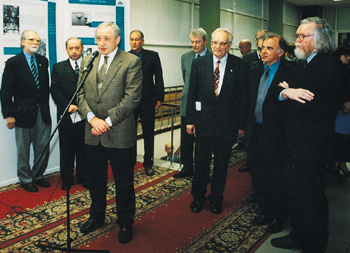Physics provides a stage for international collaboration. At the opening of a recent exhibition at the Russian Duma, presented by CERN and the Joint Institute for Nuclear Research, CERN adviser for non-member state affairs, John Ellis, explained how.

First and foremost, CERN and the Joint Institute for Nuclear Research (JINR) are centres of scientific excellence. To mention just a couple of examples, at CERN, physicists discovered the massive particles that are responsible for radioactivity and made detailed measurements that established their underlying theory, resulting in two Nobel Prizes. JINR continues to play a pioneering role in both the discovery and the study of superheavy elements, one of which bears the name dubnium.
JINR and CERN are also living evidence that science knows no boundaries. CERN has 20 member states; JINR has 18. The two organizations were both founded in the years after the Second World War to enable European and other countries to contribute to fundamental physics in ways that they could not afford individually.
Now the two organizations have several member states in common, which was impossible during the Cold War. Nevertheless, CERN and JINR collaborated actively during that dark period, extending their hands to each other across the Iron Curtain. Consequently, they were able to seize the scientific and human possibilities opened up by the fall of the Berlin Wall.
JINR is now one of CERN’s most valued international partners. It has joined CERN in many experiments using CERN’s accelerators. Thousands of students have attended the advanced physics schools that have been organized jointly throughout Europe since the 1960s. Many friendships have been formed there, which have turned into international scientific collaborations that now span the world. Hundreds of JINR-affiliated scientists and engineers are now working with CERN and its other international partners on the Large Hadron Collider (LHC) project. Working together, physicists will use the LHC to study basic questions in physics, such as the origin of mass and the nature of the dark matter filling the universe.
The future
The LHC project presents unprecedented technical challenges, such as in the areas of superconducting technology, cryogenics and informatics. In the latter field, the World Wide Web was invented at CERN in the early 1990s to enable physicists around the world to share data from LEP and analyse them together. The requirements of the LHC are driving the next stage in the evolution of the Internet – the Grid – which will enable people anywhere in the world to use remote computer power, just as today the power grid enables us to use electrical energy without knowing where it was generated.

The LHC is also an unprecedented international collaboration. The accelerator is being built with important contributions from JINR, Russia, the US, Japan, India and Canada, as well as CERN and its member states. The LHC experiments are open to scientists worldwide, who currently originate from more than 80 countries. A special role is played by the International Association for the Promotion of Co-operation with Scientists from the New Independent States of the Former Soviet Union (INTAS) and the International Centre for Science and Technology (ISTC), which have facilitated the participation by many scientists and engineers from Russia in particular.
JINR is also making many important contributions to the LHC experiments, notably to CMS, ATLAS and ALICE. The JINR contibution is both direct, through its staff working at home and at CERN, and indirect, through its coordinating role for the contributions made by Dubna member states.
Fostering friendship
CERN has fostered some unique collaborations. For example, for many years it has had Indian and Pakistani physicists working together, as well as scientists from both Beijing and Taipei. Now an Iranian group is starting to work at CERN alongside Americans. In my own area – theoretical physics – CERN has had a postdoctoral fellow from Afghanistan, and another from Iran has recently written joint scientific papers with a CERN staff member from Israel.
Many of us fear that the openness of the international system is under unprecedented attack. Scientists must thus stand together to defend our common values. This joint exhibition by JINR and CERN clearly displays our common vision. We stand for scientific excellence, international understanding, dialogue to find common solutions to common problems, openness, development and progress. In the words of the Russian empress Elizabeth Petrovna, which were quoted at the exhibition, “Enlightenment of mind eradicates evil.”
Two foundation stones
CERN and the Joint Institute for Nuclear Research, Dubna, near Moscow, were set up in 1954 and 1956 to provide a physics foundation for international collaboration. CERN set out to rebuild Western European science after the Second World War; Dubna had a similar mission for the socialist countries of Eastern Europe and further afield. Over the years, these two political spheres, isolated from each other during the Cold War, have grown closer.







